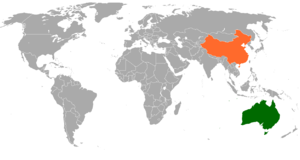From Interstate - Journal of International Affairs VOL. 1996/1997 NO. 2A Question of Identity
By
Interstate - Journal of International Affairs 1997, Vol. 1996/1997 No. 2 | pg. 1/1
KEYWORDS:
Pauline Hanson is the most controversial politician in Australia. Since early September, the Queensland MP has divided Australian opinion and dominated national news and documentary programmes. She has variously been described as the voice of the Australian subconscious and the Hitler of the southern hemisphere. The reason for these divisions was her maiden speech to the federal parliament in Canberra. A crude generalisation of her message was: Aborigines, stop ‘sponging off the state’, and Asians, go home. This article aims to examine Australia’s immigration history and to establish where Australian identity is heading. Australia is a nation of immigrants and the descendants of immigrants (1) . Described in 1788 as ‘that empty land’, Australia became the recipient of British excess population, initially as a convict colony and then as a desirable place for adventurous Britons to live. By the late 1800s, immigration from European countries such as Greece, Yugoslavia and Holland, had become significant, though was still dwarfed by the relative flood of Britons. By the beginning of the twentieth century, the government became alarmed at the size of Asian immigration in the form of boatloads of Chinese workers and other south pacific slave labour. This precipitated the Immigration Restriction Act of 1901 which required non-Europeans and other unwelcome applicants for entry to pass a dictation test administered in any European language, selected so that they would be sure to fail. However, colour was more important than nationality and citizens of South Africa were regarded for immigration purposes as British, whereas Cypriots were processed as aliens. This was the white Australia policy. In the centuries before 1788, Australia was inhabited by a small population of Aborigines. A common mispereption is that Aborigines are one people. In fact, this term refers to a number of hostile nomadic tribes, such as the Kamilaroi and the Pitjantatjara, who fought amongst each other for centuries on end. The creation of an Aboriginal identity has no historical precedence and is entirely unnatural. The tribes maintain very different cultures and speak hundreds of different languages, such as Arewan. With the onset of British and European immigration, some of these tribes assimilated themselves with white Australia, while the majority maintained their primitive, but traditional lifestyle. The Second World War had a dramatic effect on Australian public opinion. Britain, once defeated at Singapore. had been unable to defend Australia, leaving the United States to step in. While Prime Minister Menzies stated in 1939 that, as Britain was at war, Australia was also at war, the post war Prime Minister declared “The cost of this war and of future defence schemes for this country must be borne by a greatly increased population we must also be realists in regard to the necessity for a scientific migration policy.” (2) Hence a new policy was born. The white Australia policy was abandoned in favour of a goal of increasing the population from seven to thirty million in a few decades. Few objected to this change, except the Labour Party which waited until 1965 before leaving the policy out of its manifesto. Australians started to regard themselves as Australians, rather than transported Britons. Following Canada’s example of 1947, Australia declared at a conference of experts on immigration, in London, that Australian citizenship would be bestowed on its population, although they would retain their British subject status and not yet create Australian national identity. As the Australian delegates stated “a nation without citizenship is like a man without a name ” (3) The 1948 Nationality and Citizenship Act, not repealed until 1987, declared that a person who does not have the status of a British subject and is not an Irish citizen or a protected person is an alien. Indeed, Aborigines had to apply for citizenship and were not given equal civil or legal rights as white Australians. Tribesmen needed permission to marry and could not leave the country without a permit. They were not granted age or invalid pensions or maternity allowances without renouncing their Aboriginality. With pressure growing on South Africa to abolish apartheid, the Australian government sensed a change of mood both at home and abroad. Still trying to differentiate Australians from Britons (the withdrawal of Britain from east of Suez, its closer ties with the EEC, and Australian involvement in Vietnam increased Australian independence), the Prime Minister, Gough Whitlam, grasped the opportunity of founding the new Australian citizenship on equality of everyone. The Immigration Reform Group was founded in 1959 to redirect treatment of Asian applicants. The 1960’s saw the creation of an ethnic lobby and in 1962, Aborigines were allowed to vote at federal elections, irrespective of whether they were recognised by a state such as Queensland. The policy of assimilation of Aborigines and Asians was seen as cultural genocide, with traditions and life styles being forcefully abolished in order to create ‘one Australia’. The new mood of the 1960’s favoured integration of different cultures to form a multicultural society. As Jordens notes “the abolition of discrimination against non-Europeans in the grant of citizenship and the gradual erosion of racially discriminatory entry policies, undermined the white component of the popular construction of Australian national identity by the early 1970s” (4). The stereotyped Australian was no longer the white, male, ANZAC soldier of the early twentieth century. In 1992, the Queen was removed from the Oath of Allegiance and today pressure is growing for a Bill of Rights and the Republican lobby is gaining strength. Yet the 1980’s and 1990’s have seen a backlash of public opinion against the multicultural policy. Pauline Hanson has denounced the positive discrimination in favour of Aborigines in terms of benefits to relieve their primitive hardships while they maintain their separate cultural identity. She argues that if they wish to be Australians, they should leave their tribal settlements and get a proper job, and hence stop ‘sponging off the state’. Yet on a recent highly publicised tour of the Torres Straits Islands off Queensland, Hanson was shown the squalor in which many Aborigines live, with no electricity, gas or water supply and no sewage system or rubbish collection. Hanson refused to comment on what she had seen and cancelled future planned visits to similar locations. She appeared not to have expected such a level of poverty. Many commentators suggest that it is not Hanson who is the threat to multi- culturalism, but the new right wing conservatism, sparked off, according to many critics, by the influence of Thatcher and Reagan. Hanson is seen as ignorant and uniformed. In a prime time television interview, Hanson did not know the meaning of the word xenophobia and displayed significant ignorance of the economic affect that the immigrants had. It is because Australia’s population is so small that the level of immigration appears to be so high. Of a population of twenty million, immigrants represent twenty two percent. In 1988, immigration from Britain and New Zealand outnumbered immigration from the Philippines, Vietnam, Malaysia, Hong Kong, China, India and Sri Lanka. In addition to this, the poor economic conditions and high unemployment levels have created the feeling that Asians are taking Australians’jobs. The 1988 bicentennial celebrations saw “a general feeling that Australia has lost its direction and its national identity” (5) Australia’s recent failure to gain a seat on the United Nation’s Security Council after years of campaigning has led to serious questions about its place in the world. With the 2000 Olympics approaching in Sydney, and hence Australia preparing to present itself to the world, there is still a serious question of identity. Sherrington concludes ‘subconsciously, perhaps we all realise that we remain primarily a nation of immigrants. One wonders if it will ever be otherwise… ” (6). Endnotes1. A. J. Grassby, Minister for Immigration in 1973. Suggested Reading from Inquiries Journal
Inquiries Journal provides undergraduate and graduate students around the world a platform for the wide dissemination of academic work over a range of core disciplines. Representing the work of students from hundreds of institutions around the globe, Inquiries Journal's large database of academic articles is completely free. Learn more | Blog | Submit Latest in Political Science |

















